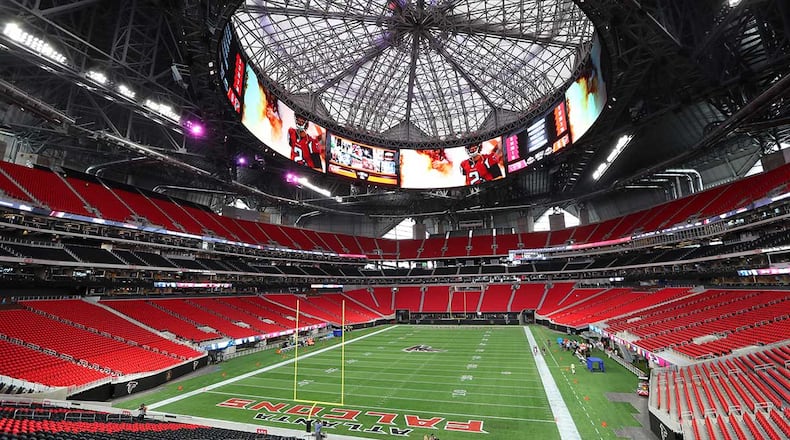When the Atlanta Falcons’ new $1.5 billion home opens with an exhibition game Saturday night, the most expensive and most discussed feature of Mercedes-Benz Stadium will remain closed.
The retractable roof isn’t ready to retract, forcing games to be played with it in the closed position until mechanization is completed. Falcons and stadium officials don’t know exactly when they’ll be able to open the roof for a game, but they say it’ll be sometime this fall.
The roof, designed to open with eight panels moving in unison from the center, has required more money, time, steel and stress than anyone involved expected.
The difficulties “had a lot to do with the fact that this roof has never been done before,” said Bill Johnson, a senior vice president of global design firm HOK and the stadium’s lead architect. “We really didn’t have the benefit of other people going before us.”
Bill Darden, president of project manager Darden & Company, put it this way: “If there was some degree of underestimation, it was … how tricky it would be to make it work.”
The roof concept was introduced by Johnson and his team — then with 360 Architecture, which subsequently was acquired by HOK — as they competed to design the stadium. Their pitch won the $35 million assignment, in part because it met Falcons owner Arthur Blank’s mandate for a building that resembled no other.
Another architect competing for the job had warned Blank about the perils of an overly complicated roof.
“One of the architects that we didn’t select — his words have been ringing in my ears the last six years — said your roof design is going to indicate how complex, how difficult (the stadium will be) to design and build,” Blank recalled.
And yet, Blank said, “we picked out the most complicated roof design that has been built in the United States, if not the world.”
While retractable roofs on other NFL stadiums have two massive moving pieces, Mercedes-Benz Stadium's eight are four different sizes and must move at slightly differing speeds. On average, each panel is more than 200 feet long and weighs almost 500 tons. The panels, called petals, move shorter distances than the pieces of the NFL's other retractable roofs, but that hardly makes up for the overall increased complexity.
“My argument about all of the ones that have come prior to us is they look like a stadium in a box,” Johnson said. “This building started with the roof, and everything else conforms to the geometry of the structure.”
When they came to Atlanta to interview for the job, 360 Architecture and engineering consultancy BuroHappold included in their presentation a scale model of the stadium they envisioned. They invited Blank to push a button to open the roof on the model.
“When Arthur pushed the button, it worked,” Johnson said.
As for all the challenges experienced since then in building the real thing, the architect said: “I do think the complexity of the roof structure is something we found out along the way. It was a lot more difficult to achieve that structure than we had originally anticipated.”
Now built, albeit not fully operational, the one-of-a-kind roof is dramatic, even in the closed position.
But “it will be open more often that it will be closed in the future,” Blank said.
If so, that will buck the trend of the four other NFL teams with retractable-roof stadiums. Collectively, the Arizona Cardinals, Dallas Cowboys, Houston Texans and Indianapolis Colts have chosen to play with their roofs open in only about one-third of the games.
Falcons CEO Rich McKay said numerous steps were taken to facilitate playing with the roof open here, such as installing an elaborate drainage system for the artificial-turf field. Team officials believe outdoor football is preferable to indoor football, he said.
“And the other thing,” McKay said, “is that I’m not sure anybody has a better climate for football than we do.”
But before the roof can be opened for a football or soccer game, there is more work to do.
The construction team has moved the roof four times so far. Rather than in 12 minutes — the time it is supposed to take to open or close the roof — the moves have required hours or even days, nowhere near fast enough for decisions based on game-day weather. So efforts continue to get the roof automated and up to speed.
“So far, the things we’ve already started to change are working really well,” Darden said.
Blank insists it's not a big disappointment to him to open the stadium with the roof closed.
“I don’t get upset, to be honest with you, over two or three months delay,” Blank said. “The roof works. It just doesn’t open and close in 12 minutes yet, but it does open and close.
“In many ways, the eight petals open and close in a way that appears to be simple. But when you get into the construction of that much weight on your roof and the weight of every petal and how they are held up and supported, it becomes very difficult to do it.”
The stadium required about 27,000 tons of steel, including 18,000 tons in the fixed portion of the roof, 4,000 tons in the retractable portion, 4,000 tons in the sides and 580 tons to support the massive oval video board. The original expectation was that a total of 12,000 tons of steel would be required.
“As they developed the drawings, they realized they needed more weight to hold up the weight. And it snowballed to what it is today,” Darden said. “There was no intention for that to happen. The reality finally caught up with the idea, if you will. And when those two points collided, it was about 15,000 tons heavier.”
The challenges of the novel design extended beyond weight.
“For everything we did, we had to invent things,” Johnson said. “We had to invent the seals that would (water-proof) the roof sections. We had to invent the button that would seal the point where they come together. We had to design two rails (for each of the petals to move on).”
He hopes the well-publicized difficulties don’t deter innovation in future stadiums.
“This building will be known around the world, and that is because we pushed the envelope,” Johnson said. “We took some risks. We did something other people were afraid to do. I feel like it’s sort of no pain, no gain.
“You’re never going to advance sports venue design beyond where it has been for the last 20 years if buildings like this don’t come forward with some bravery and suggest it can be better and it can be spectacular.”
Mercedes-Benz Stadium has other wow factors, to be sure. But the roof is supposed to provide the biggest wow.
Georgia Gov. Nathan Deal was thoroughly impressed by a tour of the stadium over the weekend — “I was just awed in my first visit here,” he said — but he also noticed what was not on display.
“The prelude to this has always been how fantastic the opening of the roof is going to be,” Deal said. “We’re still, of course, waiting for that to occur. And I’ve been given assurances that’s going to occur.”
ALL ABOUT MERCEDES-BENZ STADIUM
Look for stories about various aspects of Mercedes-Benz Stadium all week in the AJC, including these:
Today: The roof
Wednesday: The "halo" video board
Thursday: Social spaces
Friday: Technology
Saturday: A magnet for big events
About the Author
Keep Reading
The Latest
Featured




